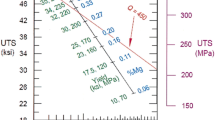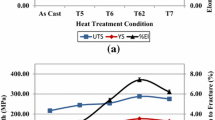Abstract
The main objective of this study was to evaluate the performance of 354-type Al-Si-Cu-Mg cast alloys at both ambient (25 °C) and elevated temperatures (250 °C) through the addition of zirconium (Zr), nickel (Ni) and manganese (Mn). The motive behind these additions was to develop thermally stable alloys capable of resisting softening instigated by prolonged exposure at elevated temperatures and hence preserve acceptable mechanical properties. Another parameter affecting performance is geometry. Four different notch geometries were employed: two hole-type geometries and two types of V-notches (symmetric and asymmetric for each). The results reveal that the presence of asymmetric notches in the tensile test bars proved to be more deleterious than symmetric notches to the notch tensile strength and percentage elongation to fracture at both 25 °C and at 250 °C. The softening that took place during tensile testing at 250 °C rendered the alloys some ductility (in particular, the M1S (354 + 0.3 wt.% Zr), M2S (354 + 0.3 wt.% Zr + 2 wt.% Ni) and M3S alloys (354 + 0.3 wt.% Zr +0.75 wt.% Mn)), as a result, the notched tensile bars with asymmetric holes exhibited high strength values for these alloys compared to the tensile strength of unnotched bars subjected to similar heat treatment conditions owing to the presence of notches. The notch sensitivity ratios vary between 0.78 and 0.95 for asymmetric holes versus 0.7 and 0.85 for asymmetric V-notches at room temperature and 0.9 and 1.07 for asymmetric holes versus 0.7 and 0.92 for asymmetric V-notches at 250 °C.










Similar content being viewed by others

References
G. Elizondo and G. Hernan, “Effect of Ni, Mn, Zr and Sc Additions on the Performance of Al-Si-Cu-Mg Alloys,” Ph.D. dissertation, Université du Québec à Chicoutimi, 2016
H.S. Jacobo, “Improving the Performance of 354 Type Alloy,” Ph.D. dissertation, Université du Québec à Chicoutimi, 2010
S.K. Shaha, “Development and Characterization of Cast Modified Al-Si-Cu-Mg Alloys for Heat Resistant Power Train Applications,” Ph.D., Ryerson University, 2015
A. Loay, “Effects of Alloying Elements on Room and High Temperature Tensile Properties of Al-Si-Cu-Mg Base Alloys,” M.Sc. dissertation, Université du Québec à Chicoutimi, 2017
R. Mahmudi, P. Sepehrband, and H.M. Ghasemi, Improved Properties of A319 Aluminum Casting Alloy Modified with Zr, Mater. Lett., 2006, 60, p 2606–2610
K.E. Knipling, D.C. Dunand, and D.N. Seidman, Nucleation and Precipitation Strengthening in Dilute Al-Ti and Al-Zr Alloys, Metall. Mater. Trans. A, 2007, 38(10), p 2552–2563
K.E. Knipling, D.C. Dunand, and D.N. Seidman, Precipitation Evolution in Al-Zr and Al-Zr-Ti Alloys during Isothermal Aging at 375–425 C, Acta Mater., 2008, 56(1), p 114–127
M.H. Abdelaziz, H.W. Doty, S. Valtierra, and F.H. Samuel, Mechanical Performance of Zr-Containing 354-Type Al-Si-Cu-Mg Cast Alloy: Role of Additions and Heat Treatment, Adv. Mater. Sci. Eng., 2018
M.H. Abdelaziz, H.W. Doty, S. Valtierra, and F.H. Samuel, Static Versus Dynamic Thermal Exposure of Transition Elements-Containing Al-Si-Cu-Mg Cast Alloy, Mater. Sci. Eng., A, 2019, 739, p 499–512
J. Hernandez-Sandoval, G. Garza-Elizondo, A. Samuel, S. Valtiierra, and F. Samuel, The Ambient and High Temperature Deformation Behavior of Al-Si-Cu-Mg Alloy with Minor Ti, Zr, Ni Additions, Mater. Des., 2014, 58, p 89–101
Z. Zeng and A. Fatemi, Elasto-Plastic Stress and Strain Behaviour at Notch Roots under Monotonic and Cyclic Loadings, J. Strain Anal. Eng. Des., 2001, 36(3), p 287–300
C. Yen and T.J. Dolan, A Critical Review of the Criteria for Notch-Sensitivity in Fatigue of Metals, University of Illinois at Urbana Champaign, College of Engineering. Engineering Experiment Station, 1952
T. Hussain, M. Memon, and Z. Mwmon, Prediction of elastic-plastic behavior of structures at notches, Mehran Univ. Res. J. Eng. Technol., 2012, 31(3), p 545–552
H. Zhu, J. Xu, and M. Feng, Singular fields near a sharp V-notch for power law creep material, Int. J. Fract., 2011, 168(2), p 159–166
D. Tanner, W. Sun, and T. Hyde, FE Analysis of a Notched Bar under Thermomechanical Fatigue Using a Unified Viscoplasticity Model, Procedia Eng., 2011, 10, p 1081–1086
H. Neuber, Theory of Notch Stresses: Principles for Exact Stress Calculation, Vol 74, JW Edwards, Ann Arbor, 1946
A. Wahl, R. Beeuwkes Jr., and E. Pittsburgh, Stress Concentration Produced by Holes and Notches, 1934
G. Sachs, et al., Nondestructive Measurement of Residual and Enforced Stresses by Means of X-ray Diffraction I: Correlated Abstract of the Literature, 1945
A.M. Agog1no, Notch Effects, Stress State, ail Ductility, 1978
P. Ludwik and I. Scheu, Notch Effects in Tests of Mild Steel Material, Stahl Eisen, 1923, 43, p 95
G.E. Dieter and D.J. Bacon, Mechanical Metallurgy, Vol 3, McGraw-Hill, New York, 1986
A. Bayram, The Influence of Manganese Addition on Mechanical Properties of Commercial Al-4 mg Casting Alloys, Materialwiss. Werkstofftech., 2004, 35(1), p 29–35
H. Yamagata, The science and technology of materials in automotive engines, Elsevier, Amsterdam, 2005
M.H. Abdelaziz, Microstructural and Mechanical Characterization of Transition Elements-Containing Al-Si-Cu-Mg Alloys for Elevated-Temperature Applications, Doctoral dissertation, Université du Québec à Chicoutimi, 2018
M. H. Abdelaziz, E. M. Elgallad, A. M. Samuel, H. W. Doty, and F. H. Samuel. “High- Temperature Tensile Fractography of Zr-, Ni-, and Mn-Containing Al-Si-Cu-Mg Cast Alloys, Adv. Mater. Sci. Eng., 2020.
M.H. Abdelaziz, E.M. Elgallad, H.W. Doty, S. Valtierra, and F.H. Samuel, Melting and Solidification Characteristics of Zr-, Ni-, and Mn-Containing 354-Type Al-Si-Cu-Mg Cast Alloys, Philos. Mag., 2019, 99(13), p 1633–1655
A. Bayram, A. Uĝuz, and M. Ula, Effects of Microstructure and Notches on the Mechanical Properties of Dual-Phase Steels, Mater. Charact., 1999, 43(4), p 259–269
Author information
Authors and Affiliations
Corresponding author
Additional information
Publisher's Note
Springer Nature remains neutral with regard to jurisdictional claims in published maps and institutional affiliations.
Rights and permissions
About this article
Cite this article
Abdelaziz, M.H., Elsharkawi, E.A., Doty, H.W. et al. Mechanical Performance of Zr-Containing 354-Type Al-Si-Cu-Mg Cast Alloy: Role of Geometrical Discontinuities. J. of Materi Eng and Perform 29, 6640–6651 (2020). https://doi.org/10.1007/s11665-020-05112-1
Received:
Revised:
Published:
Issue Date:
DOI: https://doi.org/10.1007/s11665-020-05112-1



